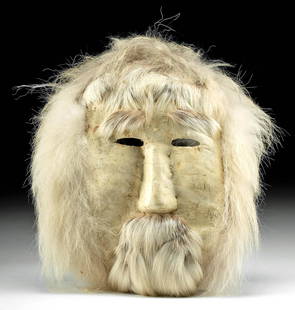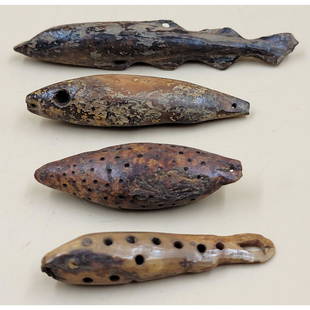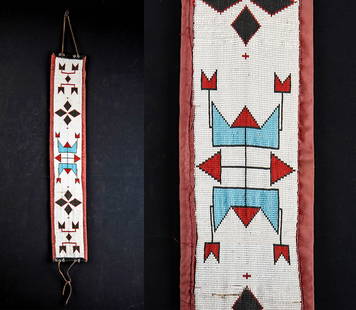

 Discovery- InteriorsBonhamsSponsored.Your ad here?
Discovery- InteriorsBonhamsSponsored.Your ad here?



Discovery- Interiors
Bonhams
Sponsored.Your ad here?


 Discovery- InteriorsBonhamsSponsored.Your ad here?
Discovery- InteriorsBonhamsSponsored.Your ad here?



Discovery- Interiors
Bonhams
Sponsored.Your ad here?

UNIDENTIFIED INUIT ARTIST, Beaded Caribou Skin Amautiq, c. 1980s
Similar Sale History
View More Items in Tribal & Native American Artifacts
Related Tribal & Native American Artifacts
More Items in Inuit Tribal & Native American Artifacts
View MoreRecommended Art
View More





Item Details
Description
UNIDENTIFIED INUIT ARTIST
Beaded Caribou Skin Amautiq, c. 1980s
caribou skin, felt duffle, cotton fabric, glass beads, wool fabric, and cotton thread, 52 x 31 x 7 in (132.1 x 78.7 x 17.8 cm)
unsigned
ESTIMATE: $10,000 — $15,000
Provenance
Collection of John and Joyce Price, Seattle.
Beaded women’s amautiit are truly among the most spectacular of Inuit art works. Soon after the introduction of colourful trade beads to Canada’s Arctic by Hudson’s Bay Company traders in the 18th century, Inuit women – most notably among the Caribou Inuit in the Kivalliq (Keewatin) Region – began incorporating them into traditional amautiq designs, and to some extent also in men’s parkas. By the mid-19th century, lavishly decorated amautiit were the height of fashion, particularly in the Kivalliq (see Hessel, Inuit Art, p. 172, for a photo of five Inuit women, c. 1904-05).
Although the great majority of amautiit created in recent decades - even those made following traditional designs – are sewn from fabrics such as wool duffle and cotton/polyester blends, a few are still sewn from caribou skin. Every step in making a truly traditional amautiq is incredibly laborious: preparing the skins through tanning, scraping, and softening; cutting and sewing the skins together in the proper proportions; and beading and affixing the decorative panels and fringes. The entire project can take many months if not years to complete, and even the most skilled seamstresses have created only a handful of these amautiit. While the overall patterns are steeped in tradition, each artist can showcase her unique skills in the creation of floral and geometric beaded designs. We hope one day to discover the name of the Kivalliq artist who created this superb example. The classic regional style, with its exaggerated shoulders and spectacular beaded decoration, is beautifully embodied in this amautiq.
References: For photos of historical and more modern parkas from this region with similar beadwork see Betty Kobayashi Issenman, Sinews of Survival: The Living Legacy of Inuit Clothing, (Vancouver: UBC Press, 1997), pp. 130, 142, 193; and Judy Hall, Jill Oakes, and Sally Qimmiu’naaq Webster, Sanatujut: Pride in Women’s Work, (Hull: Canadian Museum of Civilization, 1994), front cover, figs. 73-76, 83, 94-95, 111. For a famous historical photo (c. 1903-04) of five Inuit women wearing traditional amautiit of similar design see Ingo Hessel, Inuit Art: An Introduction, (Vancouver: Douglas & McIntyre / New York: Harry Abrams / London: British Museum Press, 1998), pl. 139, p. 172; see also Katharine W. Fernstrom and Anita E. Jones, Northern Lights: Inuit Textile Art from the Canadian Arctic, (Baltimore: Baltimore Museum of Art, 1994), fig. 2 and cat. 39, p. 12. For a similar caribou skin amautiq, by Elisapee Alareak from Arviat, see Ingo Hessel, Arctic Spirit: Inuit Art from the Albrecht Collection at the Heard Museum, (Vancouver: Douglas & McIntyre / Phoenix: Heard Museum, 2006), cat. 160, pp. 192-193; for one made of white fabric by Lizzie Naiktaa Ittinuar see ibid., cat. 161, pp. 194-195.
Beaded Caribou Skin Amautiq, c. 1980s
caribou skin, felt duffle, cotton fabric, glass beads, wool fabric, and cotton thread, 52 x 31 x 7 in (132.1 x 78.7 x 17.8 cm)
unsigned
ESTIMATE: $10,000 — $15,000
Provenance
Collection of John and Joyce Price, Seattle.
Beaded women’s amautiit are truly among the most spectacular of Inuit art works. Soon after the introduction of colourful trade beads to Canada’s Arctic by Hudson’s Bay Company traders in the 18th century, Inuit women – most notably among the Caribou Inuit in the Kivalliq (Keewatin) Region – began incorporating them into traditional amautiq designs, and to some extent also in men’s parkas. By the mid-19th century, lavishly decorated amautiit were the height of fashion, particularly in the Kivalliq (see Hessel, Inuit Art, p. 172, for a photo of five Inuit women, c. 1904-05).
Although the great majority of amautiit created in recent decades - even those made following traditional designs – are sewn from fabrics such as wool duffle and cotton/polyester blends, a few are still sewn from caribou skin. Every step in making a truly traditional amautiq is incredibly laborious: preparing the skins through tanning, scraping, and softening; cutting and sewing the skins together in the proper proportions; and beading and affixing the decorative panels and fringes. The entire project can take many months if not years to complete, and even the most skilled seamstresses have created only a handful of these amautiit. While the overall patterns are steeped in tradition, each artist can showcase her unique skills in the creation of floral and geometric beaded designs. We hope one day to discover the name of the Kivalliq artist who created this superb example. The classic regional style, with its exaggerated shoulders and spectacular beaded decoration, is beautifully embodied in this amautiq.
References: For photos of historical and more modern parkas from this region with similar beadwork see Betty Kobayashi Issenman, Sinews of Survival: The Living Legacy of Inuit Clothing, (Vancouver: UBC Press, 1997), pp. 130, 142, 193; and Judy Hall, Jill Oakes, and Sally Qimmiu’naaq Webster, Sanatujut: Pride in Women’s Work, (Hull: Canadian Museum of Civilization, 1994), front cover, figs. 73-76, 83, 94-95, 111. For a famous historical photo (c. 1903-04) of five Inuit women wearing traditional amautiit of similar design see Ingo Hessel, Inuit Art: An Introduction, (Vancouver: Douglas & McIntyre / New York: Harry Abrams / London: British Museum Press, 1998), pl. 139, p. 172; see also Katharine W. Fernstrom and Anita E. Jones, Northern Lights: Inuit Textile Art from the Canadian Arctic, (Baltimore: Baltimore Museum of Art, 1994), fig. 2 and cat. 39, p. 12. For a similar caribou skin amautiq, by Elisapee Alareak from Arviat, see Ingo Hessel, Arctic Spirit: Inuit Art from the Albrecht Collection at the Heard Museum, (Vancouver: Douglas & McIntyre / Phoenix: Heard Museum, 2006), cat. 160, pp. 192-193; for one made of white fabric by Lizzie Naiktaa Ittinuar see ibid., cat. 161, pp. 194-195.
Condition
The absence of condition does not imply that an item is free from defects, nor does a reference to particular defects imply the absence of any others. Our team can provide thorough and comprehensive condition reports and additional images. We welcome your enquiries at info@firstarts.ca or 647-286-5012.
NOTE
Many countries prohibit or restrict importation or exportation of property containing ivory, whale bone, sealskin, and/or products derived from other endangered or protected species, and require special licenses or permits in order to import or export such property. It is the responsibility of the buyer to ensure that the item is properly and lawfully exported / imported.
NOTE
Many countries prohibit or restrict importation or exportation of property containing ivory, whale bone, sealskin, and/or products derived from other endangered or protected species, and require special licenses or permits in order to import or export such property. It is the responsibility of the buyer to ensure that the item is properly and lawfully exported / imported.
Buyer's Premium
- 23%
UNIDENTIFIED INUIT ARTIST, Beaded Caribou Skin Amautiq, c. 1980s
Estimate CA$10,000 - CA$15,000
7 bidders are watching this item.
Shipping & Pickup Options
Item located in Toronto, Ontario, caSee Policy for Shipping
Local Pickup Available
Payment

TOP































































